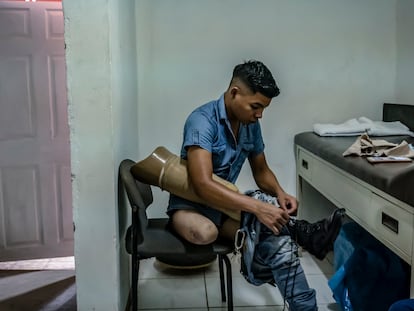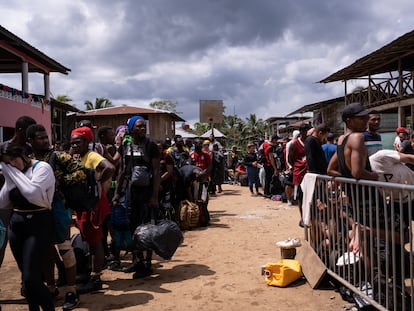Return of The Beast, the train that mutilates migrants’ dreams
In Mexico, with laws preventing undocumented foreigners from taking buses – and with many vehicles in the hands of criminal groups – migrants have turned to the feared freight train, which travels across the country to the U.S. border

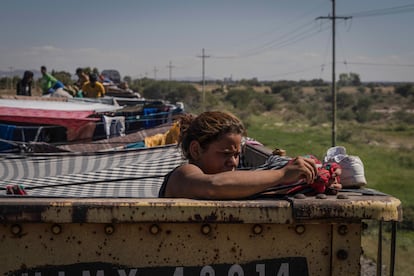
The life of a migrant — from the moment they leave their country, with burdens on their back — is like a cruel video game, where each level becomes more difficult, until the player finally reaches their goal.
First, it’s all about money — getting enough together to grab the children and close the door behind them. Then, there are the endless walks, with obstacles such as borders, corrupt guards, extortionists, or the Darién jungle, full of death and danger. In Guatemala, there are accounts of blackmail and rape. In Panama, the treatment of migrants is poor, while in refugee camps in Costa Rica, tuberculosis, fever and vomiting are rife.
After all of that, there’s Mexico. The territory — more than 1,850 miles long from south to north — is dotted with traps en route to the final stage: the United States. Many would never repeat this hellish journey. Across the country, there are buses that don’t take passengers to their promised destination and police who rape women. Migrants deal with the cold, the heat, the lack of water, the persecution by the authorities… and The Beast, the train that mutilates dreams.
The last stage of the nightmarish video game involves built up fatigue, hunger and misery. Mexico is an insurmountable level for many. When the migrants have finally managed to reach the north, one wrong move takes them back to the south, meaning that they have to start all over again. On the way to the border, Mexico — a country that is racked with its own social problems — multiplies the hardships. For those who reach the Rio Grande, it’s an additional test for the brave people who don’t know how to swim.
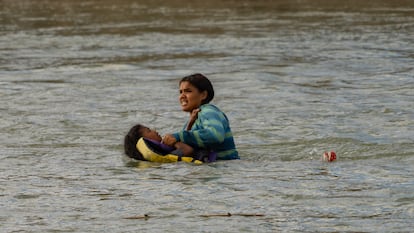
On October 11 — like so many others — a dozen migrants nearly drowned, in full view of everyone. Some lost their footing with their children on their shoulders; bodies sank and the water became a whirlpool of desperate limbs. The cries of anguish crossed like an echo from one shore to the other, stabbing the calm of a sunny afternoon. Motionless against a gentle current, the migrants on the shore were horrified as they watched the river engulf their companions. The American Border Patrol agents helped them avoid the worst: they threw floats to those who were thrashing around. Those who were swept further down the river gulped water while the U.S. lifeboats approached in an elegant, sporting zigzag. Arms rescued the bodies exhausted from the fight against the current, dragging them on board. New screams led the boats to another destination.
Some boats carried children. Others who were rescued had crutches or fresh wounds. All of them had been trying to reach the barbed wire above the embankment that encloses the riverbed. Jason — a Black man with an imposing physique, who knows how to swim — sat, exhausted, on the American shore: his girlfriend had not yet crossed. “Jason, rest, there’s no rush! Wait a little, Jason, rest!” she shouted to him, with half of her body submerged.
Meanwhile, on the Mexican side, on the same afternoon, a group of about 200 people attempted to cross the river. As they plunged in, they held hands, forming a human chain, so that they wouldn’t be separated. But nerves wreaked havoc: some got loose, clinging to the black bags that they had inflated to stay on the surface.
Incidentally, floats are prohibited — it’s a crime. Just like dragging a rope to the opposite side — that everyone can hold onto while wading with care — is also a crime. And it’s important that you arrive in the United States with a clean record to avoid being deported.
The abuses
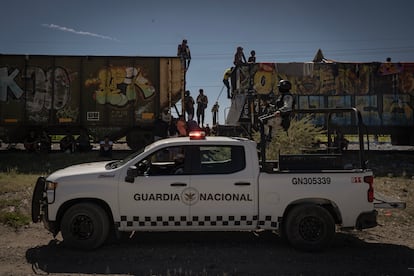
Isabel Turcios is a Salvadoran nun. She’s in charge of the Frontera Digna Migrant House, in the city of Piedras Negras, in the Mexican state of Coahuila. She angrily grabs her long brown skirt, her clenched fists shaking the clothes vigorously. She slaps her thighs furiously: “This is how they grope women. I told the police chief: ‘if you’ve given instructions to the officers to stop the abuse, those instructions aren’t getting through. They steal, they beat… the police are the ones who treat [the migrants] the worst!”
This is the first truth of Mexico, which has already been repeated across Central America. The police don’t have the authority to confront migrants: this must be done exclusively by specialized agents… the much-fear immigration officers. But uniforms of every color extort, threaten, hit or sexually abuse those who are seeking refuge. Lawyer César Barranco affirms this at the Saltillo Migrant House. “The municipal police get involved and leave them stranded anywhere. The authorities give the approval and there’s a collusion between the drug traffickers and the [extortionists] who set up checkpoints and extort them, rob them and impose their authority with physical or sexual violence. [Private security teams] have even been created — they pose as humanitarian groups,” Barranco denounces.
Jerson David Morales — a 38-year-old bricklayer from Guatemala — says: “A police officer put his knife against me and even pulled down my pants. Between Matehuala and Saltillo, they stopped the bus and a cop got on. He took money from everyone.”
In the Saltillo-based shelter, 33-year-old Catherine Morillo — who hails from Venezuela — ranks the levels of hell. First, the train: it’s even more dangerous than the jungle between Venezuela and Colombia. Overall, though, nothing compares to Mexico. “In this country, anyone can hurt you, you have to know where to go. They take advantage of you. In Guadalajara, some men offered me a job… but I learned that they were working for [bad people], they had bad intentions. What they wanted was for me to become a prostitute. I played along, said yes and escaped. Then, they sent messages, saying that they had our information. They said that they were going to kill us. I deleted the messages, I blocked them.”
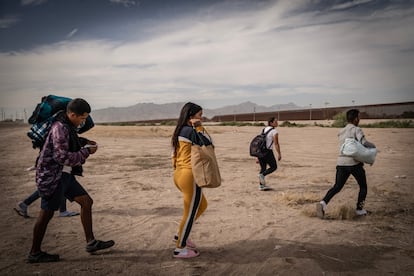
The hundreds of thousands of migrants who cross Mexico every year — people who hail from Venezuela, Colombia, Ecuador, Honduras and Guatemala — cross a map that follows the train tracks of Don Germán Larrea, Mexico’s second-richest man. He’s the owner of Ferromex, which includes the largest freight railways (by mileage) in the country.
When a legal or physical obstacle is placed in its path, the human line changes its route. Bus travel was one of the doors that was closed in 2022, with an official provision that requires travelers to present immigration documents. Barranco affirms that this is “an illegal requirement that restricts freedom of movement.” This administrative trick has led migrants to turn to an illegal transportation network, whose drivers often go in circles and drop them off in the same place (if they’re not caught along the way and deported).
Traveling on one of those buses was Santiago Meléndez, a 37-year-old Venezuela computer scientist. On October 11, he arrived at the Piedras Negras shelters, dragging his infected leg. He was injured in the southern Mexican state of Oaxaca. The truck he was riding in overturned and left 18 dead and dozens injured on the asphalt. The others ran into the darkness of the night.
This is a familiar image in Mexico. “The [bus operators] are mafias, they ask you for exorbitant amounts and they do a turn to leave you practically in the same place [where you boarded]. On October 6, our bus was speeding and several people were standing. The vehicle flipped several times: there were dead people everywhere, people crying, children... we broke the windows and got out. I ran to hide and caught another bus later. I took bus after bus after bus. Sometimes, [the drivers stopped] and asked us for money again to continue the journey. Some were dressed in black uniforms…” He remembers all of this while sitting in a chair in the shelter. He doesn’t want to look at the camera — he stares at a wall. A cricket climbs up his bare leg and he pushes it away almost gently, without looking at it. He’s not scared: what’s a cricket for someone who has seen death every day?
The train
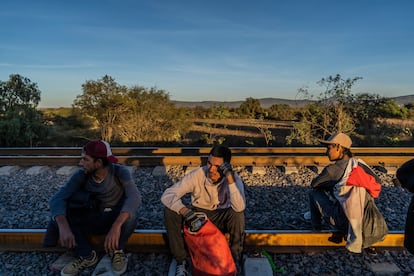
As they pass through Huehuetoca — a municipality in the very dangerous state of Mexico (Edomex) — the migrants see a white car. They flee through the ravines that flank the train tracks, seeking the shelter of the forest. The immigration vehicles that patrol the area put them on high alert. To one side, tons of garbage are unloaded — scavengers search through the waste. Dozens of birds gather in a tree, who then take flight over the tracks.
The morning is gray and wet. The migrants realize that some journalists are looking for them — they come out of their hiding places in the undergrowth. Protecting themselves from the rain with plastic bags, their shoes and clothes are torn from so many miles of walking. They wait for the whistle of the train, hoping to board as it moves.
The drizzle has left everything wet: the stirrups and bars where you can hold on to The Beast are very slippery. Richard — who was a police officer in Venezuela — and his three friends are grateful for a cigarette. The silence is thickened with the noise of the locomotive that is arriving — it’s not moving very fast. As in a bullfighting ritual, the young people tie their shoes conscientiously. They smear their hands with dry earth. In a few seconds, they’re going to risk their lives. In the distance, a sheep bleats.
When the train approaches, they make signs with their hands to slow down. The driver is now the God to whom they entrust themselves… but the train doesn’t slow down. Jumping seems too dangerous, especially with the plastic flip-flops that some of them are wearing. The cars continue on their way. The boys remain in the gravel between the tracks, silent, waiting for another opportunity. Uneasy in the rain, they continue walking, ashamed of the feat that was not.
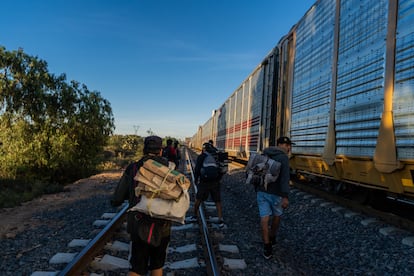
Days and miles later — in Huichapan, in the Mexican state of Hidalgo — at the foot of another shelter on the road, dozens of migrants will board the stopped train again. It’s easier this time, but it’s not without danger. Three women will fall from it. The Beast will amputate one person’s hand; it will amputate both legs from another. It’s a daily occurrence: hundreds of mutilated and dead lie under the metal wheels of the railway.
On September 19, Don Germán Larrea’s Ferromex group took 60 trains out of service, fed up with the migrants who boarded them and the news of deaths and mutilations. The continuous migratory waves were experiencing a surge those days. With buses in the hands of the mafias, the trains became a safer and faster option to go from level to level: from Huehuetoca to Huichapán, from there to Querétaro, San Luis, Monterrey, Torreón and Piedras Negras. Or maybe Torreón, Chihuahua and Ciudad Juárez.
Of course, this route isn’t simple, nor is it free of dangers. There’s always the hope that the train ride is continuous and that there’s no need to flee from immigration officers at every station, or from the criminals who hijack trains and rob migrants.
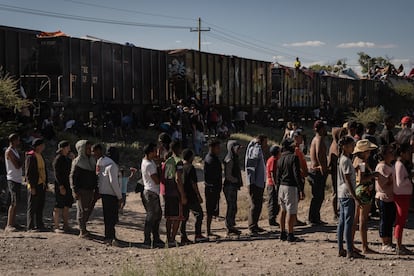
Meléndez continues staring at the wall. He spent 16 hours in total on the wagons. You cannot fall asleep when clinging to the sides or roof of the train — that would be fatal. The cold has remained in his mind. “No hunger, you don’t even think about eating anymore. You only feel sadness,” he recalls, at the Piedras Negras shelter, a few feet away from the Rio Grande… his last stage.
In the same patio — where everyone is waiting for the final departure towards the liquid border with the United States — Jaqueline Rodríguez rests for a few minutes with her two teenage daughters. “You can [make it on the train]. It’s scary, but you can,” she affirms. “What happens is that young people, [when they’re hopping on or off], don’t hold on well.” She feared for her girls a lot during the journey. They managed to get inside a railroad car, but she was always worried about criminals hijacking them. On these trips, the younger girls are hidden — kidnappings occur frequently. Those who go through this experience arrive at the shelters in a state of trauma.

Jhon Márquez, 33, arrived at La Cervecera — the key stop in Piedras Negras — and jumped from the train into a puddle of rain, where a piece of glass was hidden. It got stuck in his foot. In Venezuela, he has left his wife, a four-year-old son, his mother, and his brothers. In his eyes — which are bloodshot, perhaps from crying, or from the cold — the traume of the train remains forever. The Cuban doctor who healed his foot at the shelter is also waiting to cross into the United States.
The shelters
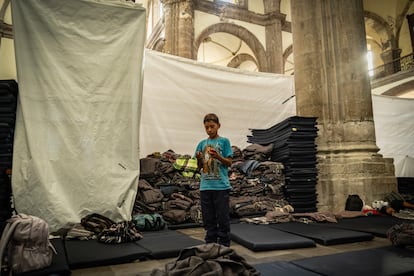
In any Latin American country, each day offers a new chapter in political instability and violence. If, long ago, it was Salvadorans, Hondurans and Guatemalans who ventured to the United States, today, there are hundreds of thousands of Venezuelans who are also trying. And if, years ago, most of the migrants were young men, today, entire families are making the journey, fleeing the torments and poverty of their nations. “A month ago, the phenomenon changed again,” said Juan Luis González Estrada, in an interview with EL PAÍS this past November. A committed layman of the Catholic Church, he’s the regent of the Huichapan shelter. “We used to receive 15 or 20 migrants a day. Now, there are about 800 a month. Before Ferromex stopped its trains in protest, we saw more than 1,000 people — maybe 2,000 — pass through the cars every day. I’ve been at this for 12 years and it still shocks me. Last year, we served 11,000 people at the shelter.”
And, in the shelters, they have so little. Rice, beans, potatoes and onions are in short supply. Not to mention meat: children go without eating protein for days. They happily fill up on cookies. They play in the yard, while their parents listen to the train’s whistle. As they wait, others continue to arrive, exhausted, dirty and wounded. The knocks on the iron door don’t stop. After they shower, they manage to joke a little: the goal is closer every day.
Some doze, while others speak of horrors. “Aren’t they human?” they ask, regarding the extortionists along the way. Women and men work in the outdoor kitchen — there are always groups of newcomers who need a hot dish.
The Huichapan shelter lives off of donations. And it exists because a woman — Doña Inés, who once herded her cattle near the railway line — found migrants dying of thirst every day. She gave them water, she observed their misfortune closely. And, one day, she donated a part of her land to build some precarious facilities that became better-equipped over time. Bunk beds, bags of clothes, a doctor’s office (without a doctor), the kitchen and showers, the dining room and the pantry. In an unpopulated territory, the wind whistles at night and Central Americans complain of the cold. They are waiting for The Beast.
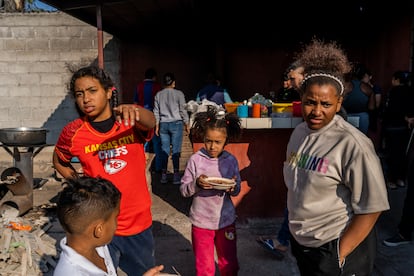
Migration is one of the big businesses of this century. Coyotes, crooked drivers, the police, organized crime and even food wholesalers profit from the hundreds of thousands of desperate people who cross the world with nothing. In countries such as Mexico, they’ll lose the little money they left their homelands with — they’ll have to try to make it back so that they don’t get stranded along the way. At this level, the Western machine continues to devour misery.
Along the Rio Grande, as it passes through Piedras Negras, there’s a beautiful park, where residents can stroll. Sitting on a bench, they can watch a young couple — the woman pregnant — trying to cross the gentle current. The water barely exceeds their knees. They move slowly, as the afternoon light begins to fade away. On the other side is a thorn-crowned embankment and American surveillance turrets.
When they finally reach the shore, they continue among reeds and wild bushes, looking for the hole through which to enter the new world. A local gives them directions out loud from the Mexican side: “A little past that, further, continue, continue.” The residents are accustomed to this cruel game — they watch the migrants as if they were watching a river regatta on TV. With solidarity — or indifference — the landscape is familiar.
Finally, the couple find a point of access. They turn themselves in to the authorities. Their destination is still uncertain.
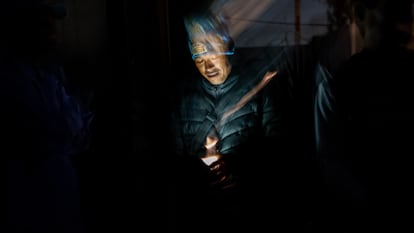
One day, the teenage daughter of Venezuelan citizens Carlos and Emily — who wants to be a doctor — may appear in the newspapers as the woman who discovered a new vaccine. Or, if she becomes a famous writer, she’ll give interviews, answering questions about her books and about how she arrived in the United States and built her future.
The children living in shelters today may become astronauts, lawyers, or senators. They will remember the hellish journey — something that no one can forget. But surely, when they grow up, thousands of other children like them will still be getting on a train and crossing the river.
Creditos
Sign up for our weekly newsletter to get more English-language news coverage from EL PAÍS USA Edition
